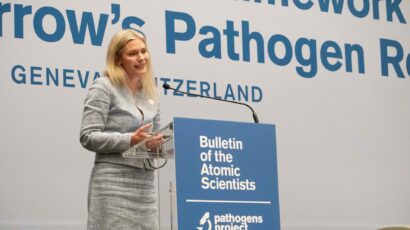Re-envisioning the Chemical Weapons Convention
By Jonathan B. Tucker | May 2, 2011
When Albert Einstein developed his theory of relativity, he made extensive use of “thought experiments” — hypothetical exercises that, while impossible to carry out in real life, are useful for testing complex theories. In one well-known case, he compared the passage of time on a train traveling at close to the speed of light with that of a stationary observer in order to elucidate a concept known as the “relativity of simultaneity.”
Similarly, thought experiments are one way to assess the implications for the 1993 Chemical Weapons Convention (CWC) of expanding the scope of the definitions in the treaty text, either through novel interpretations or by taking emerging technologies into account. For example, when the CWC negotiations concluded in 1992, the revolution in synthetic biology still lay over the horizon, so the treaty negotiators were unable to anticipate this innovation and its consequences. Three different thought experiments, each focused on revisiting a definition in the CWC, yield rather counterintuitive findings.
Thought Experiment No. 1: Toxin-producing bacteria and the CWC. Article II of the treaty defines “toxic chemical” as “any chemical which through its chemical action on life processes can cause death, temporary incapacitation or permanent harm to humans or animals. This includes all such chemicals, regardless of their origin or of their method of production, and regardless of whether they are produced in facilities, in munitions or elsewhere.” According to the State Department, the aim of this broad definition is “to prohibit all known and unknown, and future toxic chemicals in types and quantities that cannot be justified for permitted purposes. … The wording of this definition is intended to cover toxins, as well as organic and inorganic chemicals, and chemicals produced by binary and multicomponent weapons.”
Although the CWC does not define the word “toxin,” according to the generally accepted definition a toxin is a toxic chemical that is normally produced by a living organism and causes illness, incapacitation, or death. Indeed, two natural toxins, saxitoxin and ricin, appear on the CWC’s list of chemical warfare agents that trigger routine verification measures. By referring to chemicals produced “in munitions,” the CWC’s definition of toxic chemical also covers binary chemical weapons, in which two relatively harmless precursor chemicals are mixed together inside a bomb or shell during its flight to the target and react to form a lethal agent (such as sarin or VX) that is released on impact.
The inclusion of binary chemical warfare agents in the definition of “toxic chemical” suggests that the CWC encompasses toxic chemicals of natural origin, such as toxins, that are produced in some type of delivery system. A number of pathogenic bacteria exert their harmful effects by infecting the host and producing toxins; examples include the causative agents of anthrax, gas gangrene, and botulism. Once released from bacteria, these toxins interfere with cellular metabolism in specific ways to cause illness and death. Since the bacterial cells serve as the delivery systems for their respective toxins, they are analogous to binary chemical munitions. The logical conclusion: Toxin-producing bacteria are implicitly banned by the CWC if they are produced or used for hostile purposes.
Thought Experiment No. 2: Synthetic viral genomes and the CWC. When Eckard Wimmer and his colleagues at Stony Brook University in New York assembled the poliovirus genome from commercially synthesized pieces of DNA in 2002, they included in the paper describing their work the molecular formula of poliovirus (C332,652 H492,388 N98,245 O131,196 P7,501 S2,340) to make the point that a virus is actually “a chemical with a life cycle.” Because the CWC definition of toxic chemical covers toxins “regardless of their origin or of their method of production,” this definition is broad enough to include pathogenic viral genomes that have been synthesized by strictly chemical means and that, when delivered into a susceptible host, cause illness, incapacitation, or death.
Some may object that viruses produce disease by commandeering the biochemical machinery of cells and making copies of themselves, a process that results in cell death. This mechanism is obviously quite different from the action of toxic chemicals. Yet some viruses, such as the variola (smallpox) virus, express proteins that interfere specifically with the immune defenses of the host. Accordingly, whenever a synthetic viral genome encodes proteins that cause harm through “chemical action on life processes,” it potentially falls under the scope of the CWC.
Thought Experiment No. 3: Bioregulators and the CWC. Both the CWC and the 1972 Biological Weapons Convention (BWC) prohibit the development, production, and stockpiling for hostile purposes of toxic chemicals produced by living plants, animals, and microorganisms. These substances lie in the middle of the agent spectrum, which extends from standard chemical warfare agents (such as sulfur mustard) to traditional microbial pathogens (such as the plague bacterium). The CWC negotiators deliberately created an overlap between the two treaty regimes for toxins and other “mid-spectrum agents” so as to avoid a gap in coverage.
In addition to toxins, the category of mid-spectrum agents includes bioregulators: natural body chemicals that are essential for life in extremely low concentrations but can be highly toxic when delivered at high doses or in structurally modified forms. Many bioregulators are peptides, or short protein chains, including Substance P, oxytocin, and cholecystokinin. These compounds serve as messenger substances in the nervous system but, at high doses, can have incapacitating or calmative effects on the brain. Although natural peptides tend to be unstable in aerosol form and are rapidly degraded by enzymes in the body, it may be possible to develop structurally modified peptide analogues that are more persistent and capable of entering the brain from the bloodstream.
The CWC’s broad definition of toxic chemical clearly prohibits the acquisition and use of peptide bioregulators for hostile purposes, yet these compounds are not currently included in the treaty’s routine verification system. In recent years, neuropeptides such as Substance P have come to be considered as potential chemical warfare agents because of their demonstrated toxicity when inhaled in aerosol form and the newfound ability to produce them in large quantities by automated chemical synthesis — a consequence of the convergence of biology and chemistry. This emerging capability provides a rationale for developing routine CWC verification measures to monitor the production of peptide bioregulators with a potential for misuse.
Conclusions. The thought experiments discussed above make it possible to view the definitions in the CWC in a new light, yielding surprising implications that were not anticipated by the treaty negotiators. In principle, extending the scope of the CWC to cover toxin-producing bacteria, synthetic viral genomes, and peptide bioregulators could make it possible to compensate for the lack of formal verification measures in the BWC. In practice, no political will exists on the part of CWC member states to expand the scope of the treaty, so the three thought experiments do not have immediate practical applications. Nevertheless, this exercise raises an important philosophical question about the nature of the definitions contained in an arms control treaty. Should the meaning of such definitions be allowed to evolve in response to scientific and technological change, or should one continue to rely on the original intent of the negotiators, even when that interpretation has become technically obsolete?
Together, we make the world safer.
The Bulletin elevates expert voices above the noise. But as an independent nonprofit organization, our operations depend on the support of readers like you. Help us continue to deliver quality journalism that holds leaders accountable. Your support of our work at any level is important. In return, we promise our coverage will be understandable, influential, vigilant, solution-oriented, and fair-minded. Together we can make a difference.
Topics: Biosecurity, Opinion















